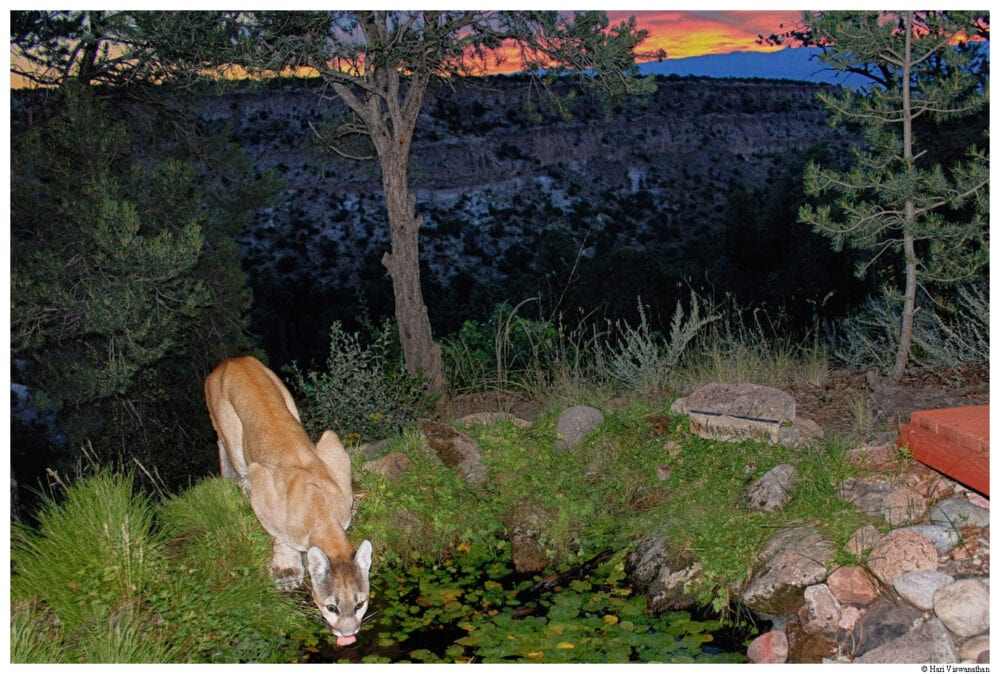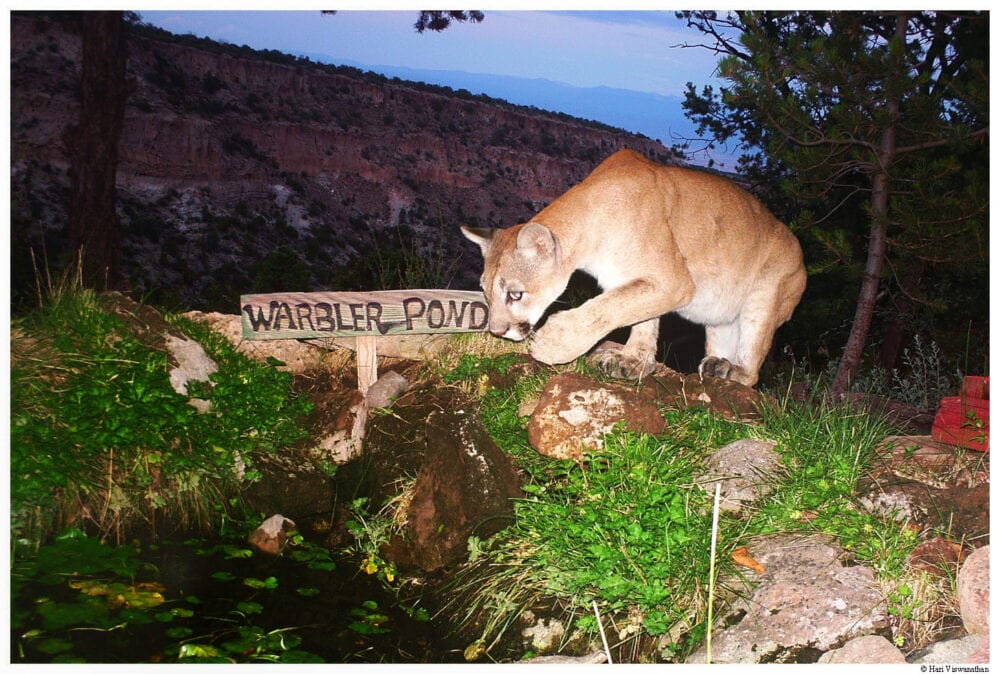
By Hari Viswanathan
Although mountain lions exist in Los Alamos and other parts of Northern New Mexico, most people will go an entire lifetime without seeing one, even if they are avid outdoor enthusiasts. These cats tend to be fearful of humans and almost always try to avoid us, even though their territories are close to many populated areas of the western United States.
In fact, mountain lions are harder to see than tigers, lions, jaguars, cheetahs, and leopards — all of which can be seen on safaris in national parks around the world with some luck. I have been lucky enough to see and photograph these wild cats in my travels over the years.
It’s a good thing that human and mountain lion populations do not often encounter one another, because these animals are extremely successful predators and are capable of bringing down prey much larger than themselves, like elk and moose. They can jump about 40 feet horizontally and 18 feet vertically, can weigh 100 to 220 pounds, and have large territories of 40 – 80 square miles.
Los Alamos and its surrounding area have good territory for mountain lions with large herds of mule deer, which are a cougar’s favorite food. They also hunt smaller animals such as coyotes, raccoons, porcupines, rabbits, squirrels, and mice and rats — all of which are common in Los Alamos. They keep prey populations healthy through their hunting.

Unfortunately, our family ended up being one of the very rare cases where a conflict occurred. Early in the morning of December 24, 2011, we had a tragic encounter with a mountain lion that attacked and killed our 70-pound pet dog, Gwennie, in our backyard that borders Pueblo Canyon. This encounter also resulted in the New Mexico Department of Game and Fish having to put down the mountain lion, who wouldn’t leave since it was protecting its kill. This was a tragic event both for our family and for the mountain lion.
Experts I spoke with after the incident believed the encounter occurred due to a combination of recent habitat loss from the Las Conchas fire, heavy snows forcing deer into town, and simply bad timing.
A post-mortem on the mountain lion indicated that he was the dominant male of the area, already had a bullet wound that he had recovered from, and was full of porcupine quills — apparently a favorite meal. I got a real appreciation of how difficult their lives are. He was perfectly healthy and was likely just doing what predators do, hunting his prey to eat.
The encounter left my family quite shaken and in April 2012, I decided to purchase a critter camera to see what wildlife was visiting our backyard. Were mountain lions visiting our backyard often without us knowing? I also purchased a critter camera for my parent’s yard that borders Barranca Canyon. The cameras would serve to both warn us and document what was visiting our yards.

My parents have a pond in their backyard wildlife habitat, so it seemed like a spot that might attract wildlife. Prior to installing the camera, we had only observed birds, chipmunks, and squirrels over the years, with an occasional bobcat. I just assumed that other mammals must not be around. Immediately after putting in the critter cameras, we were amazed at the diversity of wildlife that was visiting both backyards when no one was looking! Within a few nights of putting in the critter camera, it was clear that raccoons and gray foxes were almost nightly visitors to my parents’ backyard. Here are some highlights that the critter camera has captured in their yard. Our backyard, despite being the location of the mountain lion attack, was not nearly as active, but foxes, ringtail cats, skunks, and raccoons all visited sporadically.
On the night of May 6, 2012, a mountain lion visited my parents’ pond at 2 am! Since we had only put in the critter cameras a few weeks earlier, I concluded that maybe mountain lions were actually common. The mountain lion took a quick drink and only stayed for a minute or so. We were all curious and anxious to see when it would return. Amazingly, it did not return for an entire year. Almost like clockwork, one returned to their yard in May of 2013 and again in May of 2014.

In our own yard, the camera has only glimpsed a mountain lion once since the attack, in November of 2014. Since the critter cameras are watching 24/7, it has become clear that mountain lion visits are rare in both our backyards. Our tragic encounter does seem to have been very bad luck.
Since I started using the critter cameras, I upgraded my equipment and worked hard to try to get a good photograph of a mountain lion visiting my parents’ yard, checking for photographs almost daily! Finally, in September of 2015, a mountain lion visited for three consecutive days and I ended up with over 100 high quality photographs! It is the hardest I’ve had to work for a photo, but it really paid off. It was very satisfying to capture this elusive apex predator with the beautiful Pajarito Plateau in the background.

Capturing photos of the animal visits has actually made me feel far more comfortable about living amongst wildlife here in Los Alamos. When I check the camera and see big animals like mountain lions, bears, or deer visiting, I’m always surprised that my parents’ pond seems completely undisturbed.
Mountain lion visits are very rare and short, at least in our two backyards that are both connected to wildlife corridors due to the canyons. Bears will be destructive if they can find food in your yard, fruit trees are in season, or the trash is left out. However, if they are just visiting a water source and native vegetation, they leave things in pristine condition.
Mountain lions haven’t been seen on our critter cameras for the last two years. I was wondering why, since there seem to be plenty of deer in town. However, just a few weeks ago, I was setting up my telescope after dusk on my back deck and heard the telltale mating call of a mountain lion in the canyon. So, mountain lions are still around as they always have been, but the Ghost Cat has certainly earned its name for good reason.
Tips for Living in Cougar Country:

- Though mountain lion encounters are rare, hiking in groups and making noise while going along the trail is recommended. This will keep mountain lions and other large animals like black bears aware of your presence! Keep children close to the group.
- Keep pets inside, especially after dusk and before dawn, or walk them on a leash. If I had not let Gwennie out by herself at dawn, when mountain lions are most active, this incident would have likely been avoided. Since this incident, other problems have not occurred and we take care to only take our dog out on a leash even in our backyard if it is dark.
- Eliminate hiding places in your yard by trimming back large vegetation.
- Keep garbage sealed with a bear-resistant trash can, secure your compost, and keep pet food inside to keep curious bears, cougars, and other wildlife away from your yard. It’s also a good idea to bring bird feeders inside before it gets dark.
- When camping, keep your campsite clean and store food and garbage away from sleeping areas in a car or bear-proof canister. If you come upon a dead animal when recreating, leave it alone. It may be cougar’s kill that was left for a later meal.

EXCELLENT article with relevent details & photos presented ell. VKV
Super informative and interesting article, thanks Hari:)
Hari’s Affinity with animals is superb. So I bestow him with the Title : MODERN-DAY MOWGLI.
A very interesting article with vivid explanation.Thanks to Hari.
Hari, your article is excellent and your photographs are absolutely beautiful. I enjoyed very much the link to the highlights from the Critter Camera in your parents’ back pond. What beautiful bobcat photos those are….as well as the bear, fox and coyote photos. I had not seen the photo with the bobcat, a mouse (packrat?) in its mouth. I also found the link to the mating call of the lion very interesting. I wonder when you heard the call from your deck in the evening, did you immediately know what it was? Thanks again, Hari, for this!
Excellent presentation Hari. It must have been really hard work arraning the picutures. Best wishes.
Thank you so much for sharing your experiences with the mountain lions – I’m so glad it has not colored your opinion of them, we can share this beautiful place with them without contention, and your efforts to raise awareness and educate people make a big difference. Great article, great photos!